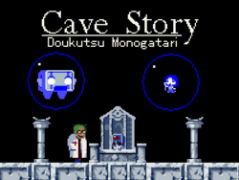Global Game Jam 2013, T.B.R.S and the reintroduction of Game Maker
Last weekend was Global Game Jam, an event that happens all over the world and brings everyone from total amateurs like myself to industry vets all together into a building (in Toronto’s case, the King St. George Brown campus), and tasks them to make a game across one weekend. You do this on your own or in as large a team as you’d like. It’s a great way of getting some experience in game design and also a fantastic way of meeting like-minded individuals.
Game Jams are basically the coolest things of all time. No exaggeration, I truly love these gatherings. Global Game Jam, in particular, has a special place in my heart as it was my introduction to the game development scene in Toronto one year ago.
Randy Orenstein and Troy Morrissey are the main organizers for the Toronto contingency of Global Game Jam (Toronto Global Game Jam, if you will), and we, as Torontonians who make games, are incredibly indebted to them for all of their hard work. I’m very grateful to have met them both. Troy has been very generous, allowing me to have interned with him for several months last year. This was a great opportunity and my first real experience working on music and sound for games, as opposed to simply writing game music for myself.
On my first day volunteering at Global Game Jam last year (which was my first encounter with this huge community), Randy scolded me for sitting in my corner reading my book, nervous and unaware of what else to do. He sat me down next to Droqen, Damian Sommer and Jon Remedios over a lunch break, which was when I started realizing I was surrounded by geniuses. It was overwhelming but also a great introduction to this whole world that was down on King street. As such I have a lot of respect for Troy and Randy, along with the many volunteer (and sponsors!) that help make game jams like this happen.
Last year I just volunteered for the clean up at the end, as I’d signed up too late to be part of the actual jam. This year however, I partnered with Daniel Orellana and we signed up in time. I had a fantastic time and I’m very proud of what we came up with.
Basically, we made a mostly functioning prototype for a game currently called T.B.R.S — Turn Based Rhythm Shooter. If that’s a mouthful, just wait til I tell you how it works:
You play as Trip, this bounty hunter of sorts who is on the hunt after this monster/thug/villain of sorts and catches up with him in a night club. Here you face off in a long series of gun and music duels, as you try to match the flurry of bullets he sends at you to the beat of the music.
The game is split up into four phases, with each phase lasting two bars of music. There is a white guiding line (think: Lumines) that scrolls across the screen, left to right signalling the passing of time. Once the white line gets to the other end of the screen the phase is over.
PHASE 1

In this phase you control Trip, dodging bullets that pulse out of the monster, all while you spin the slots. You can re-spin the slots as long as there is still time left in Phase 1. Your health bar is the big pulsing heart, while the Monster’s health is the bar in the top right corner.
PHASE 2:

In Phase 2, you continue to dodge the monster’s “bullet hell”, while selecting which of the three slots you would like to use. The options are: Regular Shot, Charge Shot and Heal (represented by a purple gun, turquoise gun or green heart, respectively). If the slots turn up more than one of the same type (such as two of the purple gun in the image above), you are given the option of selecting a more powerful attack. So if you got three of the same slots, you would have the choice between a regular, lvl. 2, or lvl. 3 version of an attack. Variety!
PHASE 3:

In the third phase, the Monster begins shooting out a more intense barrage of bullets in time to specific notes that show up at the bottom of the screen, triggered by the musical melody that plays in the background. The melody that plays is governed by your slot selection in the second phase. The “L” and “R” at the bottom of the screen correspond to the buttons that YOU will have to press in the fourth phase. They appear on the grid (and musically) as the white line travels across it.
PHASE 4:

After three phases of just dodging attacks, Trip finally gets his chance to shine! The Monster stops attacking and Trip must now press either the “L” or “R” button, shown at the bottom of the screen, in time with the melody. Each note he gets correctly makes him fire a shot. While you’re hitting those notes it’s important to line up Trip with the Monster so that his shots connect. Usually, the notes turn pink if you get them right, or grey if you miss them. In the picture above I missed all those notes because I was taking screencaps of the game.. cut me some slack!
And with Phase 4 finished, it jumps back to Phase 1! Hopefully you’ll have done more damage to the Monster’s health than you he has to you. Basically this 4 stage process goes on and on until whoever dies first, like a traditional random encounter from a JRPG of yore.
It’s very much an audio-visual game and on paper it probably sounds a bit dull, but really it’s quite exciting and fun, if I may say so myself! The original concept was by Daniel, who is an artist first, programmer second. I’m still absolutely floored by what he was able to accomplish over such a short period of time. It really blows my mind, not just him but basically all the programmers at game jams. The amount of work that goes into making stuff like this is incredibly humbling.
T.B.R.S is a mish mash of various styles (a “Bullet hell Parappa meets The World Ends With You” has been my one-sentence pitch of the game), and it’s the first time I’ve worked on something where the music isn’t just in the background, it’s a necessity for the gameplay. It’s fascinating and taps into what I think all games should do: make the music as interactive as any other element in games. Making the music at the game jam was fun but also took me a while. At TOJam 2012 I was able to churn out four songs quite quickly for “FRANK!”, which I made with the guys from Nifty Studios.

My little setup. I downscaled to a smaller keyboard for this jam. It was worth it because I had a pretty snug spot this year.. but man do I not like using such a tiny keyboard 😦
But for T.B.R.S I was still working on the one song on Sunday morning. The T.B.R.S song was composed of various smaller audio files that play based on a bunch of variables within the game. The various rhythm instruments and layers would come in and out depending on the amount of health that the Monster has left, while the various riffs and melodies (9 in all, 18 variations if you include the phase 4 counter-melodies) were all dependent on what the player chose in the slots.

Once I’d written all the melodies, I had to give Daniel the value of every note in fractions, for him to then input when the “L” and “R” buttons show up at the bottom of the screen. There is probably a quicker way of doing this.. but yeah this was the best I could come up with. We also had a couple “The Programmer meets the Musician” comedic tragedies, such as how in music you start counting on 1, instead of starting at 0.
It took a while to do, but I think subsequent T.B.R.S songs won’t take quite as long. Perceiving and arranging music not on a simple static timeline, which is what I’ve done for basically everything prior to this, is much simpler and way less time consuming. Here you have to make sure that every audio file that could potentially be played in tandem sound “good” together. You’re not arranging one song, you’re arranging hundreds of possible scenarios. Super cool. On Tuesday I took the various melodies and sections of the T.B.R.S demo and turned it into a cohesive song. You can hear it and/or buy it from my website.

The music I’ve done for T.B.R.S can be heard on my bandcamp page: http://rainvillain.bandcamp.com/album/t-b-r-s-medley-ep
We have a lot to do on this game still. Right now the Monster and Trip take damage but never actually “die”. As such there is no end to the game. It just keeps going on and on and on. We want to fix this, add a couple more levels, refine the art assets (Daniel was too busy coding all weekend that we ended up using his temp art assets for the final build!), and make the difficulty a little easier — right now the timing window for when your note is registered as a “hit” is incredibly precise and merciless, making the game very difficult for anyone who struggles with rhythm/timing. Sometime in April there will be an event for people to show off the games they made at (and polished and refined after) the Game Jam. I’m hoping Daniel and I can implement some of those tweaks by then.
The game jam itself was a ton of fun to be at and I’m already looking forward to TOJam in May. I should look into the other jams between then and now as well. The chance to talk to a lot of people in the field is a lot of fun. I spoke to several people about Stencyl vs. Game Maker and almost all of them pointed me in the direction of Game Maker. The strongest argument simply being that it has been around a lot longer and therefore has a much larger community: it’s easier to get un-stuck if there are more people in a similar boat.
As such, I’ve hopped back to Game Maker. And this time for real. No more back and forthing.
I’ve started reading The Game Maker’s Apprentice, which is beautifully written (much better than the official explanations on Stencyl) and guides you through countless tutorials. It doesn’t go into Game Maker Studio, the most recent version, so instead I’m learning Game Maker 8.1. If I get through this book I’ll upgrade to Studio.
I wanted to write a post about all the great people I saw and the amazing games I got to try at Global Game Jam but really I should get back to work.
Ok, fine. Here’s one. Grab at least three friends and lose yourself in a multiplayer text adventure.
Multiplayer Text Adventure.
Anyone with even a remote interest in the video games industry I strongly recommend you check out your nearest game jam. Whether a musician, artist, programmer, designer, writer, business guy, heck, anything, this is the best possible way of meeting people who might find you invaluable.
Oh, that and it’s STREET PASS HEAVEN AHHHHHHHHHHHHHH











